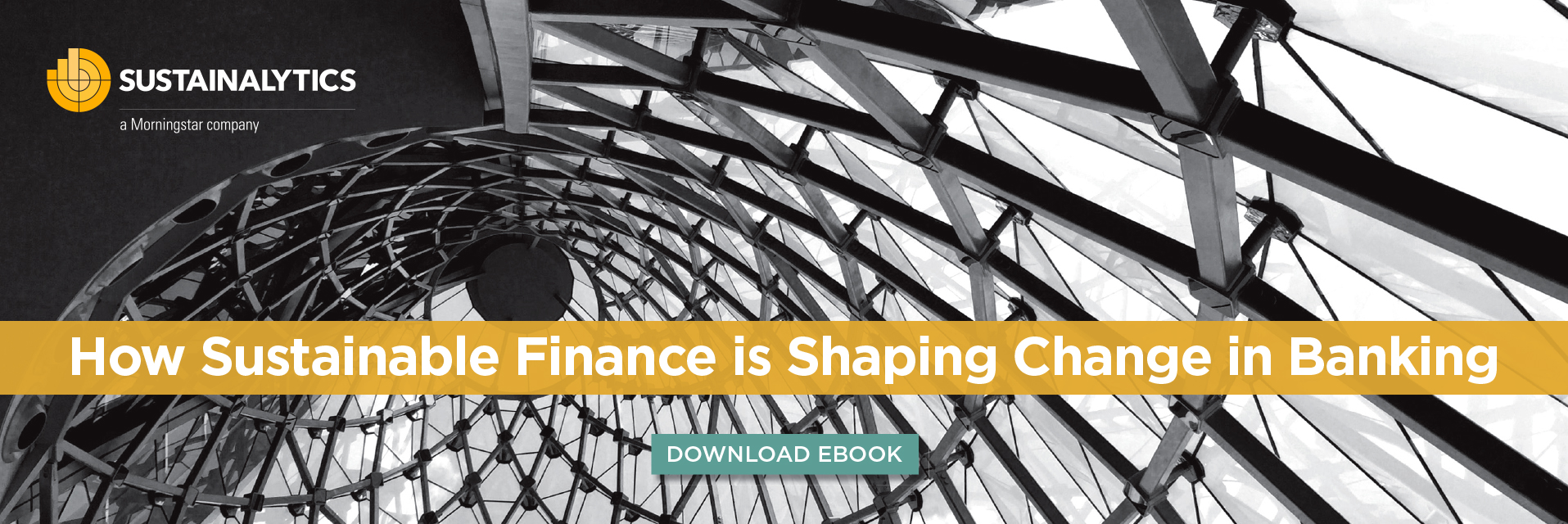Financing the Future: Conversations in Sustainable Finance is a Q&A series where we sit down with featured environmental, social, and governance (ESG) issue experts from Sustainalytics, sharing their insights on how businesses are using finance to meet the challenges of our transition to a sustainable future.
In this instalment, you’ll learn the steps banks can take to get started on their ESG journeys, plus the regulatory developments focused on climate, ESG, and sustainable finance that banks may want to get ahead of.
Sustainalytics: Happy 2022 Mayur and thanks for taking the time to speak with us again!
Mayur Mukati: Certainly, it's my pleasure.
SUST: As we begin this new year, companies across sectors, including banks, are looking for ways to better manage the ESG issues affecting their businesses and reduce potential risks. What should banks and lenders consider when starting their ESG journeys?
MM: When it comes to ESG issues and risks, banks face a unique set of circumstances compared to other corporations. In addition to examining their own operations, banks and other lenders also need to look at their investment and lending portfolios when trying to identify and manage potential ESG risks. I would say there are four primary considerations for banks embarking on their ESG journey.
- Understand the external ESG environment. What are stakeholders, such as policymakers, regulators, clients, ESG research and rating providers and consultants, talking about and focused on when it comes to ESG?
- Understand the company’s current internal ESG baseline in terms of its practices, policies, and procedures. Where do they stand when it comes to addressing the ESG issues most material to the bank? What have or haven’t they done so far? It also helps to compare their own management and policies to market leaders and industry peers and find opportunities to recalibrate their internal baseline activities.
- Once they know where they stand and how they compare to their peers, the company should develop a comprehensive strategy and action plan, clearly outlining medium and long-term commitments to effectively manage the ESG issues identified as material to the bank.
- Finally, they should set quarterly goals and execute on that action plan to achieve those medium- and long-term commitments.
SUST: We’ve seen lots of banks make public statements about their commitments to advancing ESG. But what does that look like in practice?
MM: Of course, we want companies to do more than just talk when it comes to ESG. One practice that I’ve seen among Sustainalytics’ banking clients is the creation of capacity-building programs for employees and contractors — for example, training or knowledge-sharing sessions for employees to get a better understanding of the bank’s ESG advisory and sustainable finance departments. This not only informs employees of their colleagues’ work, but it also signals the bank’s support for integrating ESG considerations within the organization.
Other banks and lenders are incorporating sustainable financial instruments into their lending practice and discussing the business case for these transactions with their clients. They’re integrating sustainable finance through incentives for clients, such as easier access to lending, a lower cost of capital, or offering better agreements for borrowers that demonstrate improvements in ESG metrics and corporate sustainability (for example, through sustainability-linked loans or sustainability-linked bonds).
SUST: Those are great examples of ESG programs in action. What about measuring and reporting?
MM: Yes, establishing such programs is key, but systematic data gathering, measurement, and disclosure are also needed. As part of the process, leading banks and lenders (and other corporations) regularly report publicly on the progress of their performance against their stated commitments.
Part of understanding the external landscape is the consideration for regulatory expectations. It’s important to keep these in mind when establishing an action plan and metrics. As banks build ESG expertise internally, they should try to exceed those expectations. In doing so, they can demonstrate leadership and potentially reduce their risk.
SUST: Going back to your first consideration when starting on the ESG journey, you noted, “understanding the external ESG environment.” Are there any legislative or policy changes banks should know about?
MM: Definitely. I would say banks in the United States, for example, need to be aware of changes in guidance from the U.S. Department of Labor. Over the past decade, the department’s tone with respect to ESG has changed multiple times, depending on the administration’s political leanings. This volatility showed investors just how much the regulatory landscape fluctuates when it comes to ESG issues in the U.S. Are ESG considerations part of investors’ fiduciary responsibilities? Should these issues be integrated into decisions and reported on? The answer in the U.S. depends on who’s in charge.
This is in stark contrast to how the European market, including the United Kingdom, has placed consistent emphasis on the integration and reporting of ESG issues by investors and corporations.
In Canada, banks should take note of the federal government’s plans around climate reporting. The government is considering mandating that company reporting be aligned with the Taskforce for Climate-Related Financial Disclosure (TCFD). The government will also require federally regulated institutions, including government agencies, banks, and pension funds, to issue net-zero plans and adopt mandatory climate-related disclosures. The mandatory climate-related disclosures will include requirements for Scope 3 reporting and scenario analysis per TCFD recommendations. These federal rules create more stringent requirements than those proposed by provincial securities commissions, which would allow companies to explain why critical information (i.e., scenario analysis) was omitted.
SUST: Is there anything on the international regulatory front that banks should have on their radar?
MM: As I’m sure many of our readers are aware, the International Sustainability Standards Board (ISSB) was launched at COP26. This was quite a significant development coming out of the event and should continue to influence the market going forward. There are also underlying discussions around the climate and general disclosure requirements created by the Technical Readiness Working Group (TRWG) to support the development of standards. TRWG suggests banks disclose financial information that is relevant to the significant sustainability-related risks and opportunities of an entity. It also suggests climate-related disclosure in line with TCFD recommendations.
SUST: Any suggestions for banks and lenders wanting more detail on how climate issues are impacting their portfolio companies and how they can report on that data?
MM: There are too many to name. I’ve published a blog post listing some of the climate-related initiatives and organizations that I think banks and lenders should engage with, or at least be aware of, to support better climate-focused measurement and reporting. I encourage readers to check it out. (Read Measuring What Matters: Initiatives for Banks' Climate-Related Impact and Disclosure).
SUST: In terms of sustainable finance for issuers, in your opinion, what are the current themes banks should take note of, and why?
MM: Since banks work closely with companies issuing sustainable finance instruments — as lenders or underwriters of sustainable loans, bonds, and sustainability-linked instruments — it’s important for them to be aware of the climate-related focus areas for issuers. To me, biodiversity and water (ocean-related conservation) seem to be the most prominent emerging themes at the moment. There’s been a lot of noteworthy activity around biodiversity, from the development of governance structures and initiatives, such as Nature Action 100+, to increasing global dialogue and commitments, including the Kunming Declaration at the Conference of the Parties (COP15).
We expect to see corporations and intermediaries discussing and/or issuing novel financing structures related to biodiversity in the near future. For example, a sustainability-linked bond (SLB) could be issued by a company, with a performance target of net-zero biodiversity loss in the medium term (as per emerging recommendations under Nature Action 100+).
On sustainable finance issuance, we’ve seen growing interest in developing hybrid sustainable finance frameworks where issuers want to retain the flexibility to issue either use of proceeds instruments, linked instruments or both. And in the U.S., our team is seeing significant growth in the issuance of securitized transactions, such as green and/or social mortgage-backed securities. These transactions see a pool of loans to eligible green or social assets used as collateral in securitized transactions.
I expect that we’ll continue to see more diversity among sustainable finance issuers with novel transactions, including sovereigns and financial institutions coming up with SLBs addressing material environmental or social issues. And following international dialogues such as COP26 and COP15, I expect issuers will consider tapping the SLB market to highlight their climate and nature-related commitments.

Recent Content
Landmark Rules Ask Companies to Grapple With Climate Risk Very Publicly
Ron Bundy hosts an interview with Gabriel Presler, Global Head of Enterprise Sustainability at Morningstar and Aron Szapiro, Morningstar’s Head of Retirement Studies and Public Policy, to discuss what the new SEC rule and other climate regulations mean.
Financing the Future: An Interview on High ESG Risk Industries and Opportunities for Banks
Companies in industrial conglomerates, steel, diversified metals, precious metals, and oil and gas producers can make take meaningful steps to reduce their material environmental, social, and governance (ESG) risk – and the negative impacts that go along with those risks. But they need guidance and access to finance. Read on to learn how banks are working with clients in these high-risk industries to set and meet targets for material improvements on ESG risk factors.







